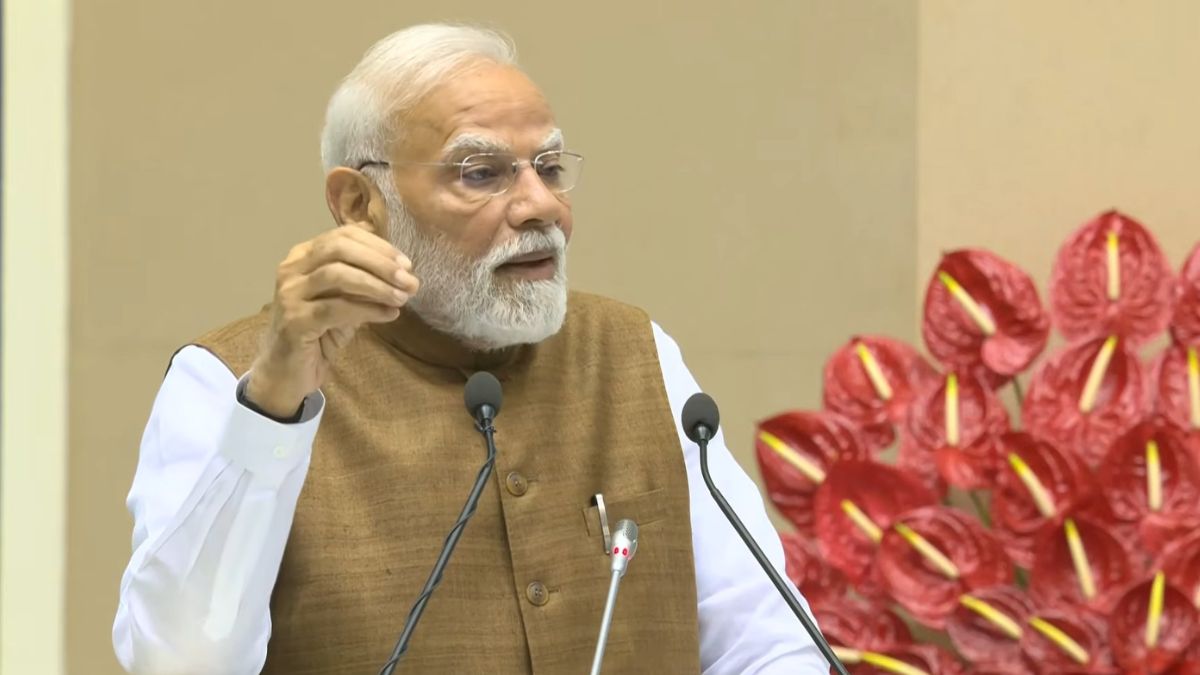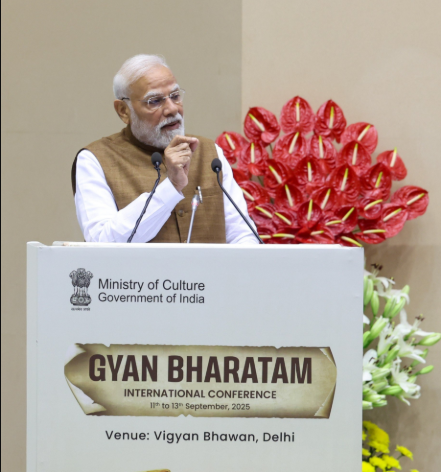PM Modi Launches ‘Gyan Bharatam Portal’ to Boost Manuscript Digitisation
PM Modi launches Gyan Bharatam Portal at Vigyan Bhawan, New Delhi, to digitise and preserve manuscripts, enhancing public access and cultural heritage.
Shivanshu Pathak

PM Modi Launches Gyan Bharatam Portal to Digitise and Preserve India’s Manuscript Heritage
India’s vast collection of ancient manuscripts—estimated at over five million—holds timeless knowledge spanning philosophy, medicine, astronomy, linguistics, and literature. However, much of this treasure remains inaccessible due to decay, lack of cataloguing, and limited public access. In a landmark cultural and digital initiative, Prime Minister Narendra Modi launched the Gyan Bharatam Portal on October 8, 2025, during the inauguration of the 9th India Mobile Congress (IMC) at Yashobhoomi, New Delhi.
Developed under the Ministry of Culture, the digital platform seeks to digitise, preserve, and democratise India’s manuscript heritage. It aligns with the government’s ‘Viksit Bharat 2047’ vision—using advanced technologies like AI, machine learning, and cloud storage to make rare manuscripts searchable, translatable, and accessible to scholars worldwide. The portal is envisioned as a central hub for India’s civilizational knowledge systems and a digital bridge between heritage and innovation.

Launch Highlights and Key Features
The portal was launched at IMC 2025, Asia’s largest technology event, highlighting how cultural conservation can coexist with cutting-edge innovation. During the launch, PM Modi described manuscripts as “the silent witnesses of India’s intellectual evolution” and urged citizens, libraries, and private collectors to join the digitisation movement.
Key features include:
Comprehensive Digitisation: Targeting 10,000 manuscripts in phase one, covering Sanskrit, Tamil, Persian, and regional languages.
AI-Powered Tools: OCR for ancient scripts, automated metadata tagging, and multilingual translation.
Global Accessibility: Free public access for scholars with options to download high-resolution annotated texts.
Collaborative Framework: Partnerships with IGNCA, universities, and UNESCO.
Backed by a ₹500 crore allocation in the 2025 Union Budget, the initiative will expand to 50,000 manuscripts by 2030. Early collaborators include the National Manuscripts Mission and state archives from Kerala and Uttar Pradesh.
Significance for Culture, Education, and Research
The Gyan Bharatam Portal arrives at a time when India’s Digital Public Infrastructure (DPI)—exemplified by UPI, Aadhaar, and CoWIN—is transforming governance and access. The new portal extends this model to knowledge preservation, addressing long-standing challenges like manuscript decay, fragmentation, and loss due to natural or human factors.
Reviving Traditional Knowledge
For centuries, India’s manuscripts have preserved systems like Ayurveda, Yoga, Jyotish (astronomy), Arthashastra (economics), and Vastu (architecture). Digitisation opens doors for researchers to cross-link traditional theories with modern science. For instance, AI models can now compare Ayurvedic pharmacology texts with biomedical databases to rediscover ancient medicinal insights.
Strengthening Education and Research
Aligned with National Education Policy (NEP) 2020, the portal encourages universities to integrate India’s indigenous knowledge systems into modern curricula. Digital archives can be used to create new interdisciplinary programs in linguistics, heritage studies, and AI-assisted translation research. It also enables data-driven cultural analytics, where historians and coders can collaborate using machine learning to analyze writing styles, chronology, and regional variations.
Boosting India’s Soft Power
Internationally, the initiative enhances India’s position in cultural digitisation, similar to the British Library’s Endangered Archives Programme or the Google Arts & Culture Project. Open access to these manuscripts not only safeguards heritage but also strengthens India’s soft power diplomacy by showcasing its intellectual legacy to the world.
Challenges and Future Roadmap
Digitising centuries-old manuscripts presents several technical and legal challenges. Many manuscripts use scripts such as Grantha, Sharada, or Modi, which have limited digital recognition support. Developing OCR models and training AI systems for these ancient scripts requires significant linguistic expertise.
Copyright and Ownership:
Private collections and institutional archives pose copyright and ownership challenges. To address this, the government plans legal support mechanisms under the Indian Antiquities and Art Treasures Act (1972) to ensure proper accreditation and fair use.
Regional Representation:
Ensuring equal representation for manuscripts across all states, including tribal and folk traditions, remains a priority. Regional workshops will be held to train local volunteers in digitisation techniques and metadata entry.
Roadmap Ahead
The next phase will integrate Gyan Bharatam with the National Digital Library of India (NDLI) and the Bharat Knowledge Graph, creating a unified knowledge infrastructure. By 2027, the platform aims to introduce AI translation bots capable of converting ancient texts into 15 Indian and 6 global languages.
The portal’s open nomination drive, inviting citizens to register manuscripts for digitisation, will continue until December 2025. To encourage participation, awards will be given to the top 100 contributors and institutions that preserve and upload the highest-quality manuscripts.

International Conference on Gyan Bharatam
To complement the digital initiative, the Ministry of Culture hosted a three-day International Conference on Gyan Bharatam from September 11–13, 2025, under the theme “Reclaiming India’s Knowledge Legacy through Manuscript Heritage.”
Over 1,100 participants from India and abroad—including archaeologists, linguists, technologists, and policymakers—attended to discuss best practices in digitisation, preservation ethics, and access frameworks.
Sessions covered:
Digital archiving standards and metadata protocols.
Ethical digitisation and public domain access.
AI-assisted restoration of damaged manuscripts.
Global collaborations for heritage cloud infrastructure.
An accompanying exhibition displayed ancient palm-leaf manuscripts, Jain scriptures, and medieval scientific texts. Prime Minister Modi toured the exhibition, emphasizing the role of youth and startups in building indigenous technology for cultural preservation.
Conclusion
The Gyan Bharatam Portal marks a defining moment in India’s cultural renaissance—a fusion of heritage and high technology. It transforms manuscripts from fragile artifacts into living, searchable repositories of wisdom. By safeguarding ancient knowledge through AI and cloud infrastructure, India takes a decisive step toward a Viksit Bharat where innovation honors tradition.
As PM Modi said during the launch, “This is not just preservation, but revival.”
The initiative ensures that India’s timeless knowledge—once locked in fragile manuscripts—now becomes a global, digital resource for generations to come.

About Shivanshu Pathak
Shivanshu Pathak is a contributor to Bharat Station, sharing insights and updates on government news and policies.
Comments (0)
No comments yet. Be the first to comment!